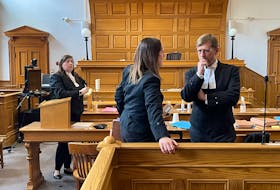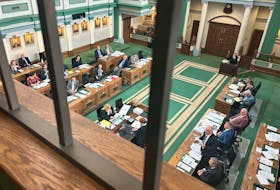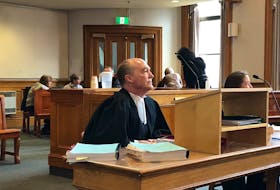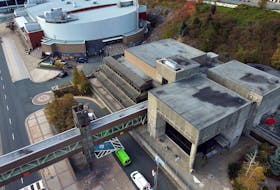ST. JOHN'S, N.L. — A proposed residential development in one of the last and largest naturalized green spaces in downtown St. John’s has prompted a range of concerns.
A designated heritage building in the Ecclesiastical District national historic site, the Cathedral Parish Hall on Queen’s Road, and the land which extends up the hill to Harvey Road, is conditionally sold by the Anglican Diocese of Eastern Newfoundland and Labrador to developer Parish Lane Development Inc., pending city approval of rezoning.
The proposal for two buildings, which would house 40 residential units altogether, would require the green space currently zoned open space, and the Hall, currently zoned institutional, to both be rezoned as commercial central mixed-use (CCM). It would also require a municipal plan amendment.
The proposal will go to a public meeting on Nov. 27 before city council makes a decision, likely in January.

Archdeacon Roger Whalen previously told The Telegram the Anglican diocese is selling the Parish Hall because “it was completely inaccessible” for the aging congregation (the hall itself was located on the second floor, accessible only by stairs), and it’s an “old building (that) really needed to come down.”
He said it was easier for the diocese to sell the Parish Hall, and build a new, accessible one adjacent the Anglican Cathedral.
This was the controversial annex application withdrawn in August after public outrage and speculation that it might disturb graves in the churchyard.
At the time, both the annex committee chair Paul Antle and Mayor Danny Breen said they would meet with stakeholders in September to discuss that related proposal further, but a city spokesperson told The Telegram the meeting has now been scheduled for early December because the Cathedral delegation wasn’t available until then.
Proponent’s perspective
Parish Lane Development Inc. CEO Rick Pardy said many of the concerns expressed by St. John’s residents were top of mind as the proposal was developed.
“We’ve tried to do a project that is very good for the community from an architectural perspective, historic preservation perspective, protecting view planes, protecting as many trees as we can, and we think we have an excellent project for the community,” said Pardy.
He said structural engineers have said the Cathedral Parish Hall is past the point of being saved.
“Because it was rebuilt over the existing foundation, we now have a foundation failure, and the structural architects have said it is failing the structure, so this building will not survive unless something is done.”
Regarding the green space, Pardy said a full tree inventory was done on the site and they identified 15 trees “with substantial trunks.” They are committed to keeping nine of those trees, mostly on the perimeter of the site buffering between the Kirk and the homes on Garrison Hill.
"We basically wanted an extension of The Rooms." — Rick Pardy, Parish Lane Development Inc. CEO
“It’s not just the residents that want the trees – it’s everybody, including the developer and, eventually, the families that will live there.”
Pardy said the market will dictate whether the residences are rented or sold as condos. For now, they are calling them simply "residences."
He said the development would be energy efficient with geothermal heating, and underground parking with electric car chargers in all parking spaces.
Paul McDonald, a realtor with Sutton Group Aurora Realty, who has been hired to sell or rent the units if or when the project is completed, said he has already heard from people interested in living there.
He said many downtown apartments are less than 1,000 square feet, but the high-end Parish Lane Residences will range from 1,500 to 3,500 square feet, with views of the downtown and harbour.
“That product does not exist in the downtown core today,” said Pardy.
Asked whether the proposal can be altered based on the upcoming public engagement, Pardy said, “there’s always going to be change,” but they’ve been working on this proposal for a year.

“Of course, we’ll listen to input, and with open ears, but I can’t stress enough the amount of effort that’s gone into producing what we think is an outstanding project.”
The architect for the proposal is Philip Pratt, who also designed The Rooms.

“The reason we went to Philip Pratt, we basically wanted an extension of The Rooms, and we asked Philip, if we could develop the site, would it be OK? And Philip was on board with it. He said, ‘Absolutely, we can make this beautiful, and integrate it almost like an extension,’” said McDonald.
He estimates the units will generate $400,000 annually in tax revenue for the city.
“A lot of people were talking about low-income housing, and we’re all for that, too, but these taxes can be used for that.”
McDonald is sharing a survey about the proposal in response to a petition circulating against the open space rezoning. The survey is available online by searching Parish Lane Residences on Facebook. He said they were curious to see who is supportive of the development.
Residents’ worries
Area resident Amy Evans said she would like the city to protect the green space by rejecting the open space rezoning, but she would welcome some kind of redevelopment of the Parish Hall site – a viable solution to the concerns because the proposal requires rezoning two different sections. Council could potentially approve the institutional rezoning, but deny the open space rezoning.
While Evans said the space is used often by area residents who tap the maple trees and whose children play there, it’s “not human use that makes it valuable – it’s nature in and of itself.”
Her neighbour, John Weber, said it’s the largest naturalized green space still remaining in the downtown core, and for that reason alone it should be protected.
“With the climate emergency that the city just declared, it doesn’t make sense to tear down trees. You don’t tear down trees when you’re trying to take carbon dioxide out of the atmosphere,” Weber said.
Evans agreed it seems “inconsistent” to her for council to vote for the climate emergency declaration, and then approve rezoning open space to commercial space.
The neighbours are part of a group circulating a petition to save the green space. They have both a printed petition and an online change.org version, titled "Save the Last Naturalized

Green Space in Downtown St. John’s."
Weber estimates they’ve gathered 2,500 signatures so far.
Another Garrison Hill resident, Josh Smee, said most of the neighbours have expected some kind of redevelopment of the Parish Hall.
“This is absolutely the right place in the city to put more density,” he said, but added the proposal would be more attractive to him if it were more focused on providing affordable housing such as what Cochrane Street United did by turning part of the church into affordable housing units.
Smee worries that if the city approves rezoning of the open space to CCM, and the development falls through for some reason, the open space will remain rezoned to CCM.
“So, any other developer could then pick up the land and do anything that was permitted within the zoning with fairly minimal ability of the city to intervene on that. So, I think there’s some concern there that the final product might not look like what’s being presented.”
Heritage considerations
“This is very troubling,” said John Fitzgerald, a Newfoundland historian and executive director of the Basilica Heritage Foundation.

“They’re doing this in the middle of a national historic district. It’s not a site, it’s a district, and the district has 27 national historic sites or persons within its radius. There’s nothing like this in Canada. There’s very little like this in the world.”
Fitzgerald said he has been working on getting the Ecclesiastical District recognized as a world heritage district.
“We will never get that if we start destroying national historic sites in our precinct. So, we have to choose. Do we want a condo tower in the middle of an Ecclesiastical Precinct which is a national historic district?”
Fitzgerald was among four people who organized an informal meeting on Nov. 13 to discuss the proposal in advance of next week’s public meeting. Other organizers included Heather MacLellan, a retired assistant deputy minister of culture and heritage and former superintendent of national historic sites with Parks Canada; Dr. Anne Walsh, pastoral associate at St. Theresa’s Parish; and Colleen Shea, retired from public programming at The Rooms.
He said at least 70 people attended the meeting.
Fitzgerald said that in 2006 and 2007 all of the churches in the Ecclesiastical District were asked their permission to designate their properties.
“The Anglicans agreed to this, and this is very troubling – are they turning their back on this now? Because if you demolish a national historic site, not only is it under threat, you just obliterated it.”
Fitzgerald said if indeed the Parish Hall is “trashed,” then the best course of action is to preserve what can be saved and adaptively reuse the building, with any construction done carefully, in a sympathetic style using the design of the existing architecture.
“There are many ways to do something down there. This proposed condo tower is not one of them.”
Fitzgerald is pushing to put a hold on the application until an appraisal is done of the Ecclesiastical District’s value to the tourism industry.
“Here we are in a province that’s in tricky economic circumstances. We can use everything we have. We can use every resource we have, and this is a major one.”
Fitzgerald said the national designation means buildings in the district can apply for funding to maintain their properties. Demolishing one of the buildings, he said, will jeopardize what Historic Sites and Monuments calls the commemorative integrity of the national historic district. He said that will make it more difficult for other heritage properties in the area to get federal funding.
“I do not understand the mentality of people who want to demolish national historic sites. It’s like going up with a bulldozer and knocking down Cabot Tower.”

From the Anglican East NL’s report of the commission on parish renewal and viability titled “Surviving or Thriving: The Future of the Church in the Diocese of Eastern Newfoundland and Labrador,” released last month, the diocese lists “Heritage designations for some buildings” as a threat, along with other threats such as “Negative perception of the church.”
Under a section of the report on property management, it states, “It is clear from analysis of the Parish Profiles that this diocese has too many buildings. Congregations and vestries have become fixated on maintaining the buildings that their ancestors have built.”
Minutes from the city’s Built Heritage Experts Panel meeting with the developer on May 15 say it appears the panel is open to de-designation of the Parish Hall, with assurances on the implementation of the applicant’s plan through legal documentation. The minutes say the panel would review the developer’s land use assessment report before making any recommendations on amending the heritage designation.
On Parks Canada’s directory of federal heritage designations, some of the character-defining elements for the Ecclesiastical District include “the various landscape features including trees, shrubs and open spaces” as well the Parish Hall.
“Overall, visual impact is achieved through the use of varying materials, architectural styles and open spaces,” reads part of the description of the district by Parks Canada.
The city’s perspective
City council development lead Coun. Maggie Burton said council will review the proposed development like any other: based on the individual merits of the development, public input, how it aligns with the municipal plan and development regulations.

While Burton would not comment on the application directly, she did say it’s important for council to ensure it is balancing the needs of improving access to residential units while also living up to its climate-action promises.
“I know that people are really responding to that since we had our climate-emergency declaration recently, but there’s a lot to consider when it comes to adding density to the city versus adding more greenfield (undeveloped land) development at the urban-rural fringe, for example. So, there are a lot of considerations, and a lot of different sides to this.”
Burton said condo, apartment or residential vacancy rates are not something council considers with development proposals because every development has a different target market.
She noted people are eager to become engaged on developments earlier in the process, as evidenced by the informal grassroots meeting.
“I’ve spoken publicly before about the need to review an application before the design is finalized, for example, so people can comment on the architecture. So often we hear from proponents that it’s a pretty finalized design before it even goes out to public engagement.”
Anyone unable to attend the public meeting can email their thoughts about the development to [email protected].
Twitter: @juanitamercer_
Note: If you're a subscriber reading this story on the Telegram website and want to comment on this story, please go to SaltWire.com and log in to our commenting platform using your member information.
RELATED








